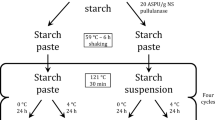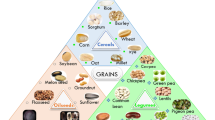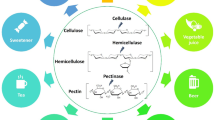Abstract
Special malt with high gluten-specific peptidase activity was prepared by germinating barley grain for 8 days at 18 °C and 48 % humidity. Endogenous malt peptidases were characterized and used to degrade gluten in barley wort. Peptidases of aqueous malt extracts degraded celiac-active peptides by cleaving peptide bonds involving proline residues. The peptidase activity was not affected by cultivar, area of cultivation, and high temperatures up to 80 °C during kiln drying. Temperatures up to 50 °C were tolerated without loss of full activity in aqueous solution. The presence of ethanol decreased the activity significantly. Cross-flow filtration, freeze-drying, and evaporation under reduced pressure at 50 °C were used to produce a concentrated enzyme-active malt extract. The latter method yielded the best results, and the obtained concentrate was used to study gluten degradation in barley wort as affected by concentration of the extract, incubation time, and temperature. The gluten content was determined by a competitive R5-ELISA. The addition of 10 % concentrated extract (grist-to-water ratio 1:2.5; 40.4 °Brix) to wort and incubation for 24 h at 50 °C resulted in a gluten-free wort.


Similar content being viewed by others
References
Maiuri L, Troncone R, Mayer M, Coletta S, Picarelli A, de Vincenzi M, Pavone V, Auricchio S (1996) In vitro activities of A-gliadin related synthetic peptides. Damaging effect on the atrophic coeliac mucosa and activation of mucosal immune response in treated coeliac mucosa. Scand J Gastroenterol 31:247–253
Ellis HJ, Pollock EL, Engel W, Fraser JS, Rosen-Bronson S, Wieser H, Ciclitira PJ (2003) Investigation of the putative immunodominant T cell epitopes in coeliac disease. Gut 52:212–217
Wieser H, Koehler P (2008) The biochemical basis of celiac disease. Cereal Chem 85:1–13
Codex standard for foods for special dietary use for persons intolerant to gluten. Codex Alimentarius, International food standards. CODEX STAN 118-1979, adopted in 1979; amended 1983; revised 2008. Rome, Italy
Wieser H, Koehler P (2012) Detoxification of gluten by means of enzymatic treatment. J AOAC Int 95:356–363
van Landschoot A (2011) Gluten-free barley malt beers. Cerevisia 36:93–97
Dostálek P, Hochel I, Méndez E, Hernando A, Gabrovská D (2006) Immunochemical determination of gluten in malts and beers. Food Addit Contam 23:1074–1078
Hartman G, Koehler P, Wieser H (2006) Rapid degradation of gliadin peptides active for coeliac disease patients by proteases from germinating cereals. J Cereal Sci 44:368–371
Gessendorfer B, Koehler P, Wieser H (2009) Preparation and characterization of enzymatically hydrolyzed prolamins from wheat, rye, and barley as references for the immunochemical quantitation of partially hydrolyzed gluten. Anal Bioanal Chem 395:1721–1728
Kerpes R, Knorr V, Procopio S, Koehler P, Becker T (2015) Gluten-specific peptidase activity of barley as affected by malting and its impact on gluten degradation. J Cereal Sci (submitted)
MEBAK (2006) Mitteleuropäische Brautechnische Analysenkommission. Collection of brewing analysis methods of the Mitteleuropäische Brautechnische Analysenkommission (MEBAK). Barley, adjuncts, malt, hops and hop products. MEBAK, Freising, Germany
Gessendorfer B, Hartmann G, Wieser H, Koehler P (2011) Determination of celiac disease-specific peptidase activity of germinated cereals. Eur Food Res Technol 232:205–209
Schwalb T, Wieser H, Koehler P (2012) Studies on the gluten-specific peptidase activity of germinated grains from different cereal species and cultivars. Eur Food Res Technol 235:1161–1170
Baenziger PS, Clements RL, McIntosh MS, Yamazaki WT, Starling TM, Sammons DJ, Johnson JW (1985) Effect of cultivar, environment, and their interaction and stability analyses on milling and baking quality of soft red winter wheat. Crop Sci 25:5–8
de Ritis G, Auricchio S, Jones HW, Lew EJ-L, Bernardin JE, Kasarda DD (1988) In-vitro (organ culture) studies of the activity of specific A-gliadin peptides in celiac disease. Gastroenterology 94:41–49
Wieser H, Belitz H-D, Ashkenazi A (1984) Amino-acid sequence of the coeliac active gliadin peptide B 3142. Eur Food Res Technol 179:371–376
Beal AD, Mottram DS (1993) An evaluation of the aroma characteristics of malted barley by free-choice profiling. J Sci Food Agric 61:17–22
Wieser H, Belitz H-D, Idar D, Ashkenazi A (1986) Coeliac activity of the gliadin peptides CT-1 and CT-2. Eur Food Res Technol 182:115–117
Shan L, Molberg Ø, Parrot I, Hausch F, Filiz F, Gray GM, Sollid LM, Khosla C (2002) Structural basis for gluten intolerance in celiac sprue. Science 297:2275–2279
Qiao SW, Bergseng E, Molberg O, Jung G, Fleckenstein B, Sollid LM (2005) Refining the rules of gliadin T cell epitope binding to the disease-associated DQ2 molecule in celiac disease: importance of proline spacing and glutamine deamidation. J Immunol 175:254–261
Fraser JS, Enoel W, Ellis HJ, Moodie SJ, Pollock EL, Wieser H, Ciclitira PJ (2003) Coeliac disease in vivo activity of the putative immunodominant epitope. Gut 52:1698–1702
Arentz-Hansen EH, McAdam SN, Molberg O, Kristiansen C, Sollid LM (2000) Production of a panel of recombinant gliadins for the characterisation of T cell reactivity in coeliac disease. Gut 46:46–51
Arentz-Hansen H, Körner R, Molberg O, Quarsten H, Vader W, Kooy YM, Lundin KE, Koning F, Roepstorff P, Sollid LM, McAdam SN (2000) The intestinal T cell response to gliadin in adult celiac disease is focused on a single deamidated glutamine targeted by tissue transglutaminase. J Exp Med 191:603–612
Arentz-Hansen H, McAdam SN, Molberg Ø, Fleckenstein B, Lundin KE, Jørgensen TJ, Jung G, Roepstorff P, Sollid LM (2002) Celiac lesion T cells recognize epitopes that cluster in regions of gliadins rich in proline residues. Gastroenterology 123:803–809
Vader W, Kooy Y, Van Veelen P, De Ru A, Harris D, Benckhuijsen W, Peña S, Mearin L, Drijfhout JW, Koning F (2002) The gluten response in children with celiac disease is directed toward multiple gliadin and glutenin peptides. Gastroenterology 122:1729–1737
Vader LW, Stepniak DT, Bunnik EM, Kooy YMC, de Haan W, Drijfhout JW, van Veelen PA, Koning F (2003) Characterization of cereal activity for celiac disease patients based on protein homology in grains. Gastroenterology 125:1105–1113
Tye-Din JA, Stewart JA, Dromey JA, Beissbarth T, van Heel DA, Tatham A, Henderson K, Mannering SI, Gianfrani C, Jewell DP, Hill AV, McCluskey J, Rossjohn J, Anderson RP (2010) Comprehensive, quantitative mapping of T cell epitopes in gluten in celiac disease. Sci Transl Med 2:41–51
Acknowledgments
This research project was supported by the German Ministry of Economics and Technology (via AiF) and the FEI (Forschungskreis der Ernährungsindustrie e.V., Bonn), project number AiF 16791N. The authors would furthermore like to thank Florian Gschwendtner for excellent assistance and Dr. Jean Titze from Doehler Group for providing the facilities and knowledge for the upscale.
Author information
Authors and Affiliations
Corresponding author
Ethics declarations
Conflict of interest
None.
Compliance with ethics requirements
This article does not contain any studies with human or animal subjects.
Additional information
Verena Knorr and Roland Kerpes have equally contributed to this work.
Rights and permissions
About this article
Cite this article
Knorr, V., Kerpes, R., Wieser, H. et al. Production and application of barley malt extract with high peptidase activity for the degradation of gluten in wort. Eur Food Res Technol 242, 585–597 (2016). https://doi.org/10.1007/s00217-015-2568-x
Received:
Revised:
Accepted:
Published:
Issue Date:
DOI: https://doi.org/10.1007/s00217-015-2568-x




